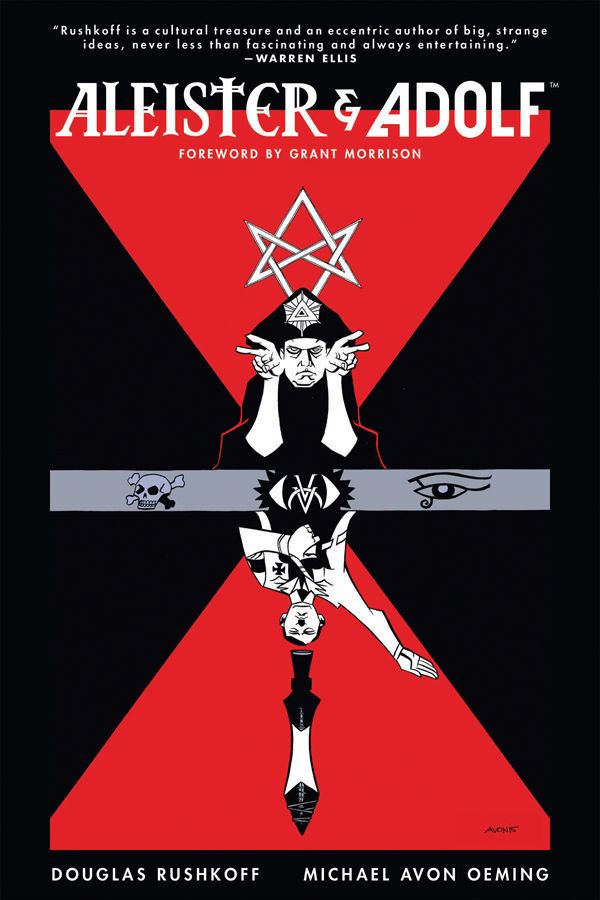
This graphic novel, quite simply, is a treatise on belief and magic, delivered through storytelling and torn from history.
Bookended by events which transpired during the rise of the internet in the mid-1990s, the meat of this narrative takes place over the course of World War II, when Aleister Crowley conspired with the military intelligence communities in both England and the United States in an effort to stop Adolf Hitler and the Nazis from achieving their goal of world domination. The conceit mirrored throughout is that of the young initiate out of their depth, taking fateful steps into a larger mystery, and it works remarkably well here, since this book is as much an info dump for the basics of sigils as anything else. As the reader, we are the outer layer of the onion, the latest wide-eyed sacrificial goat to experience the ritual.

Our tale begins and ends with Hugh, a tech-savvy Industrial rock musician whose day job with an advertising firm has him attempting to upload corporate logos for the Netscape launch, though it has proven more difficult than first imagined. To rectify the issue, Hugh is directed first to Mr. Stubbs, and then to Mr. Roberts, men who served together at the time of the Second World War and know the insidious origins of the uncooperative logos. Roberts proceeds to enlighten us, spinning a yarn that involves General Patton, Nazi Officer Rudolf Hess, Ian Fleming (creator of James Bond), British Spymaster Maxwell Knight, and the “wickedest man in the world,” Aleister Crowley.
Crowley takes Roberts, who has been tasked with instigating a propaganda war, under his leathery, wizened wing as he uses astrology and ritual to instruct England on how best to combat Hitler’s ever-encroaching Third Reich. The fomer Army photographer sees the infamous mage fall out of favor with MI5 over time, yet continue the fight by stumbling upon and charging the letter “V” sigil, used by Prime Minister Churchill in the “V is For Victory!” slogan. Conflict arises when Roberts gets sidetracked by an obsession he and his superiors have with the spear that Hitler was rumored to possess, one which is said to have pierced Christ while he was dying on the cross, and made its controller invincible. It eventually leads to a falling out with his former teacher, and is ultimately used in a grisly murder, one which will be channeled into a certain corporate logo.

What author Douglas Rushkoff has expertly crafted here is a compelling primer on what a great deal of mystical thought is predicated upon: that reality is guided by our will, and that will is informed by belief. The Swastika, the V for Victory, the Spear of Destiny, and our modern corporate logos are all as powerful as we wish them to be. If you buy into such things, of course. History has proven that many great and powerful men did exactly that, which certainly makes for a persuasive argument. While the interactions here barely scratch the surface of the events which transpired in the late 30s and a large portion of the 40s, most of it really happened, and the rest, as Rushkoff explains, “…may as well have. It’s all how you connect the dots.” There’s so many of those dots, and so many ways to connect them, that a tapestry of constellations forms. It’s a rabbit hole full of big questions, and one you tumble into at your own risk.
Providing the visuals for this collaborative endeavor is Michael Avon Oeming, an artist and illustrator most famous for his work on Powers and The Mice Templar. His art has a stark, design-minded quality that makes it a perfect pairing for subject matter so severe and ideas so powerful. He employs techniques that include toner dot shading and swirling grey washes, the former providing a cold, classical edge to architecture and technology, and the latter breaking all of that down when the journey snakes into the hallucinatory world of drug-fueled sex rituals. The artwork swings effortlessly between the mundane and the deranged, not only because the script demands it, but also to show us just how easily our inhibitions can be eroded. Crowley would be pleased.


For those who prefer a deeper dive when investigating history, those adventurous spirits who seek out the inward journey, and those who just want a hit of some intoxicating, weird shit when they crack open a book, this will satisfy, if only temporarily. I’ve found that once my perceptions have been screwed with and all sorts of sexy new philosophical quandaries have been presented that there’s no going back. There’s only that insatiable desire to dig, and get under the veneer of everything. Of course, your mileage may vary, so by all means, “Do what thou wilt.”




